8 Best Native Plants for Oklahoma City
BY JANAE SOULES | APRIL 1ST, 2023 | LANDSCAPING, OKLAHOMA, OKLAHOMA CITYAfter a visit to the Myriad Botanical Gardens, you’re inspired to have a beautiful native landscape. Whether you want to add a new pop of color or do your part for the ecosystem with native plants, we’ve got you covered with the 8 best native plants for Oklahoma City.
Patience is often needed when growing native plants from seeds, as some may take a couple of years before the beauty appears, but it is well worth it.
In this article, we’ll cover:
- Purple Poppy Mallow
- New England Aster
- Butterfly Milkweed
- Crossvine
- Blue False Indigo
- American Black Elderberry
- Evening Primrose
- Purple Coneflower
- How to Choose Native Plants for Your Oklahoma City Landscape
- FAQ About Native Oklahoma City Plants
- Where to Find Native Plants in Oklahoma City
8 Best Native Plants for Your Oklahoma City Home
1. Purple Poppy Mallow (Callirhoe involucrata)
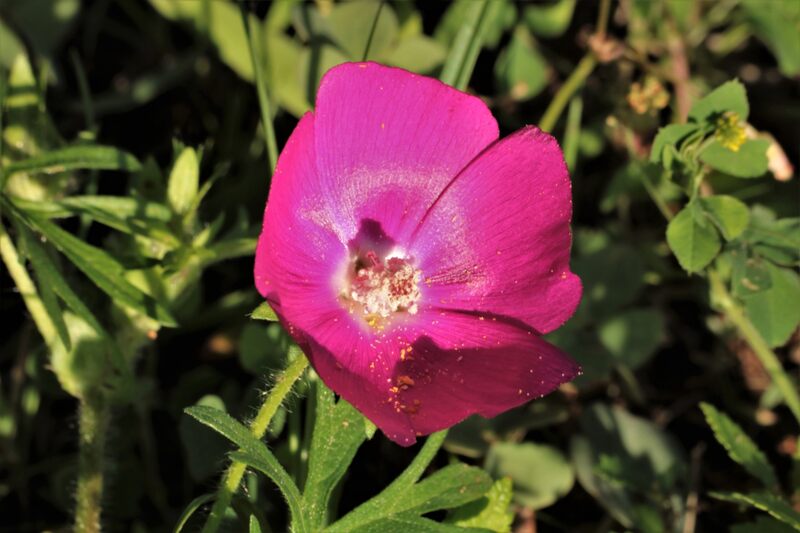
Photo Credit: PublicDomainPictures
Purple poppy mallow is a drought-tolerant flowering native plant. The magenta cup-shaped flowers bloom in late spring to early summer to give your garden a bright pop of color and attract butterflies and hummingbirds.
Purple poppy mallow does not thrive in moist soil–– ensure your soil is medium to dry and well-draining to avoid rust. The flower may self-seed if the growing conditions are favorable and can be grown as a ground cover.
Plant type: Flowering ground cover
USDA Hardiness Zone: 3 to 8
Sun: Full sun, partial shade
Soil: Rocky, sandy, loamy, clay
Duration: Perennial
Fragrance: No fragrance
Bloom time: Late spring to early summer
Water needs: Medium
Mature height: Up to 1 foot
Maintenance: Can prune in late summer if desired
2. New England Aster (Symphyotrichum novae-angliae)

Photo Credit: hedera.baltica / Flickr / CC BY-SA 2.0
New England aster is another wonderful native flower for your OKC garden if you want to attract bees and butterflies. It boasts a range of colorful flowers, including purple, blue, white, and pink.
The leaves on New England aster are rough and hairy. These flowers flourish well in moist soil with good air circulation.
Plant type: Flower
USDA Hardiness Zone: 4 to 8
Sun: Full sun, partial shade
Soil: Sandy, loamy, clay
Duration: Perennial
Fragrance: No fragrance
Bloom time: Late summer, autumn
Water needs: Medium
Mature height: 3 to 6 feet
Maintenance: Medium. May require staking or other support if it grows tall. Pinch back stems before midsummer to control the plant height and produce more flowers.
3. Butterfly Milkweed (Asclepias tuberosa)
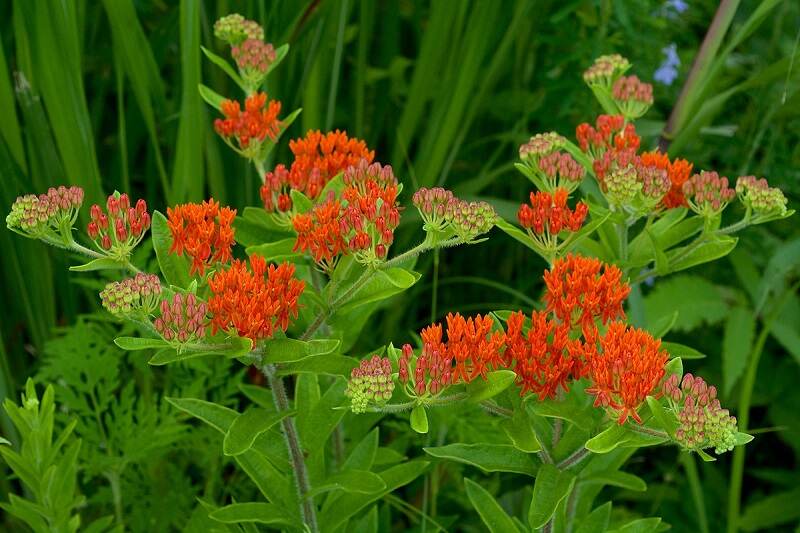
Photo Credit: Eric Hunt / Wikimedia Commons / CC BY-SA 4.0
If you already have a butterfly garden or wish to have one that gets abundant sun, check out butterfly milkweed for your Oklahoma City backyard. Its bright-colored orange and yellow flowers attract not only butterflies but also rabbits. Consider metal fencing around your butterfly milkweed so a monarch butterfly can enjoy it, but the rabbits cannot.
Butterfly milkweed is low-maintenance, even in the aspect of watering–– once established, butterfly milkweed only needs occasional watering and prefers dry soil.
The downside to butterfly milkweed is that it can have invasive qualities due to large seed pods that disperse small seeds with hairs that spread with the wind. Remove ripened seed pods if you don’t want the plant to spread.
Plant type: Perennial herb
USDA Hardiness Zone: 3 to 9
Sun: Full sun
Soil: Clay, loam, sand
Duration: Perennial
Fragrance: Sweet, vanilla
Bloom time: May to September
Water needs: Low
Mature height: 1 to 2 feet
Potential hazards: Poisonous to cats, dogs, livestock, and people when ingested
Maintenance: Low
4. Crossvine (Bignonia capreolata)
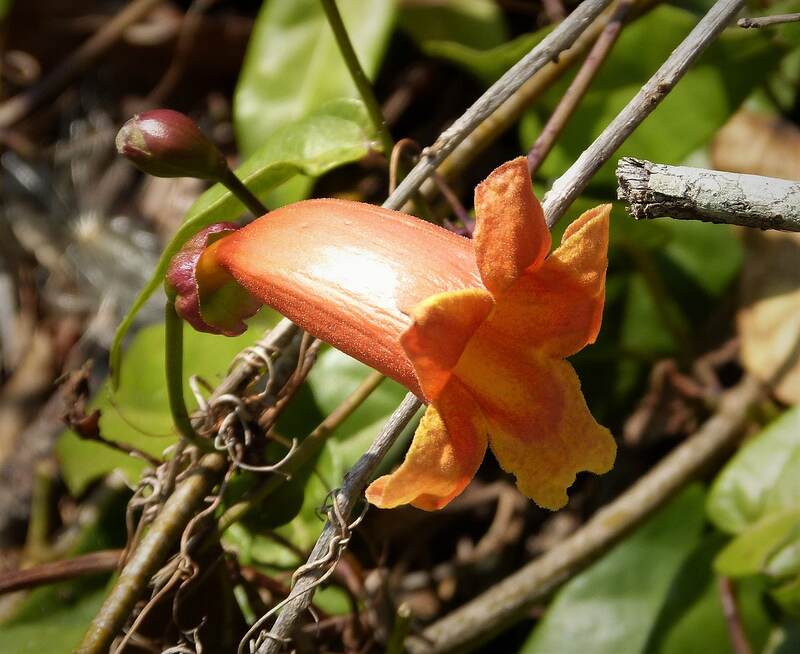
Photo Credit: gailhampshire / Wikimedia Commons / CC BY 2.0
Crossvine is a vine with green leaves and trumpet-shaped yellow and orange flowers. If you were to look closely at the stems on crossvine, you would notice the crisscross pattern–– hence the name.
If your landscape is part shade, you can still grow crossvine, but it won’t flower as much as in a full sun yard.
Ensure you plant the crossvine with abundant space–– these vines can grow an impressive 30 to 50 feet high and 6 to 9 feet wide. Crossvine is often used on fences, trellises, walls, or as a ground cover. Crossvine will move across the ground if there is not a vertical structure for it to climb up.
Plant type: Vine
USDA Hardiness Zone: 6 to 9
Sun: Full sun, partial shade
Soil: Sandy, loamy, clay
Duration: Perennial
Fragrance: Mocha
Bloom time: Mid-spring to late summer
Water needs: Low to medium
Mature height: Climbs up to 50 feet
Maintenance: Prune to keep the desired shape
5. Blue False Indigo (Baptisia australis)
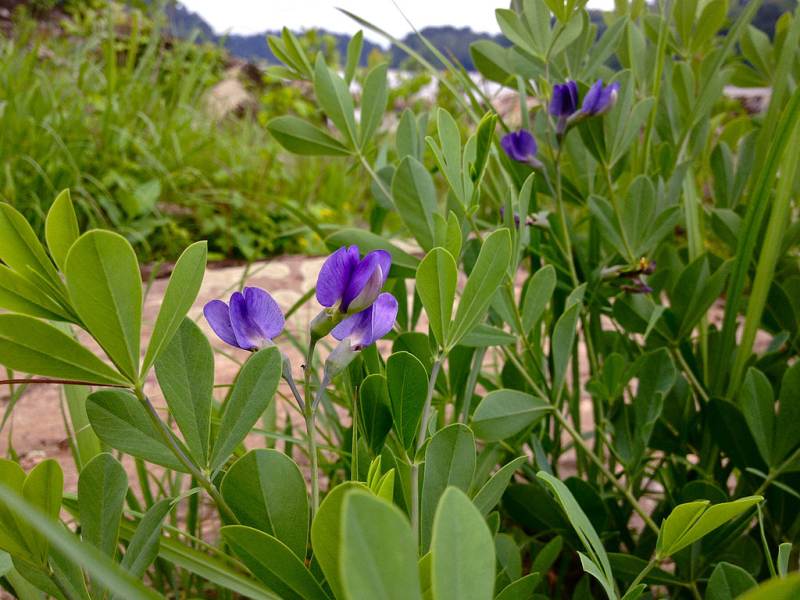
Photo Credit: Fritzflohrreynolds / Wikimedia Commons / CC BY-SA 3.0
Blue false indigo is a fantastic option if you want to add some bright, beautiful color to your native garden. It is a perennial flower but can have a shrub-like appearance. As beautiful as blue false indigo may be, avoid planting it in your garden if kids or pets frequent the area–– it is mildly toxic to people and pets if ingested.
Blue false indigo has blue-purple flowers which attract bumblebees from April to July. Keep blue false indigo planted in full sun to avoid it flopping over. Good air circulation is also needed for blue false indigo to remain happy–– without it, the plant might develop a fungal disease, such as leaf spot or rust.
Plant type: Upright perennial
USDA Hardiness Zone: 3 to 9
Sun: Full sun
Soil: Loam, sad
Duration: Perennial
Fragrance: None
Bloom time: April to July
Water needs: Low, average
Mature height: 3 to 4 feet
Potential hazards: Poisonous to cats, dogs, livestock, and people when ingested
Maintenance: Low
6. American Black Elderberry (Sambucus canadensis)
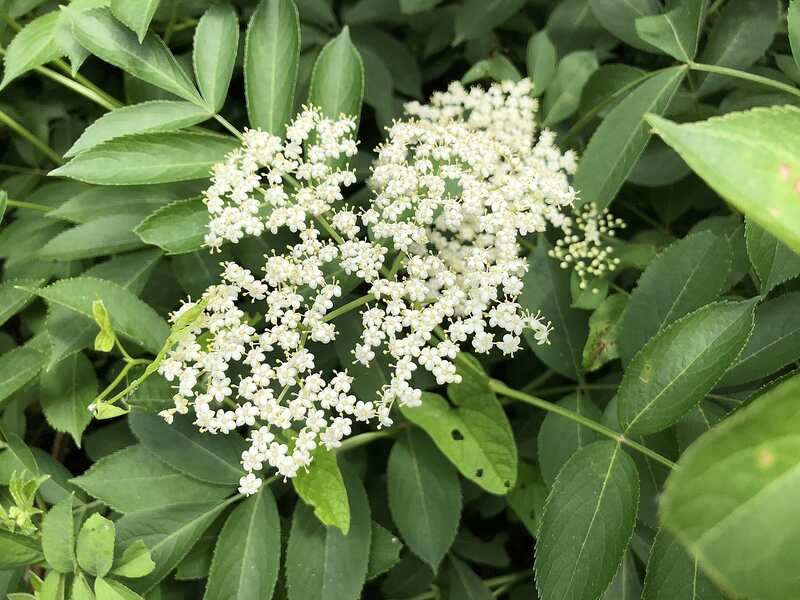
Photo Credit: Famartin / Wikimedia Commons / CC BY-SA 4.0
American black elderberry, also known as common elderberry, is a native shrub with white flowers that bloom from May to July with dark purple fruits following the flowers in late summer. It can be grown in a location with either full sun or partial shade and moist soil with good air circulation.
American black elderberry fruit is edible and full of antioxidants–– it can be used for jellies or wines, but it needs to be cooked, dried, or fermented before consuming.
Plant type: Shrub
USDA Hardiness Zone: 4 to 10
Sun: Full sun, part shade
Soil: Tolerates a wide variety of wet to dry soils but prefers rich, moist, slightly acid soil
Duration: Perennial
Fragrance: Sweet
Bloom time: May to July
Water needs: Medium
Mature height: 5 to 8 feet
Potential hazards: Raw elderberries are toxic and should not be consumed
Maintenance: Regular pruning to remove suckers from the base of plant
7. Evening Primrose (Oenothera biennis)
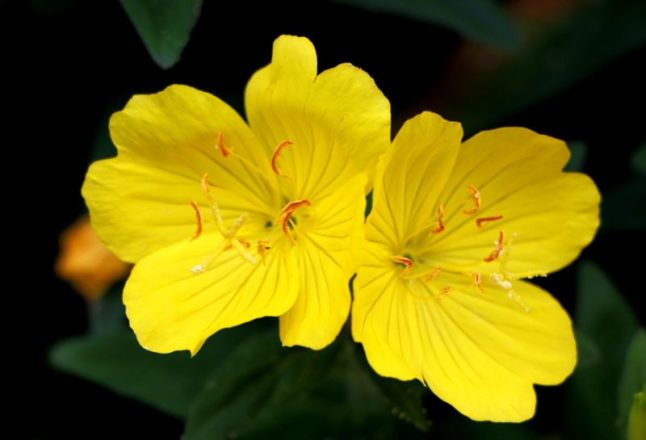
Photo Credit: Pixabay
Evening primrose is a beautiful plant with four-petaled yellow flowers and a leafy stem. It is often viewed as an invasive weed because of its self-spreading seeds, but it can be a wonderful addition to your native garden with minimal work.
Evening primrose needs full sun (even though the flowers open at night), well-draining soil, and snipping of expired blooms to reduce the self-spreading of the seeds. During especially hot OKC summers, you may need to give your evening primrose some additional water.
Holistic properties have been associated with evening primrose, which is why it’s also known as the cure-all plant.
Plant type: Herbaceous
USDA Hardiness Zone: 4 – 9
Sun: Full sun to partial shade
Soil: Sandy, gravelly, medium moisture, well-drained soil.
Duration: Biennial
Fragrance: Mild lemon
Bloom time: Early summer to early fall
Water needs: Medium
Mature height: 3 to 5 feet tall, 2 to 3 feet wide
Maintenance: Snip expired blooms
8. Purple Coneflower (Echinacea purpurea)
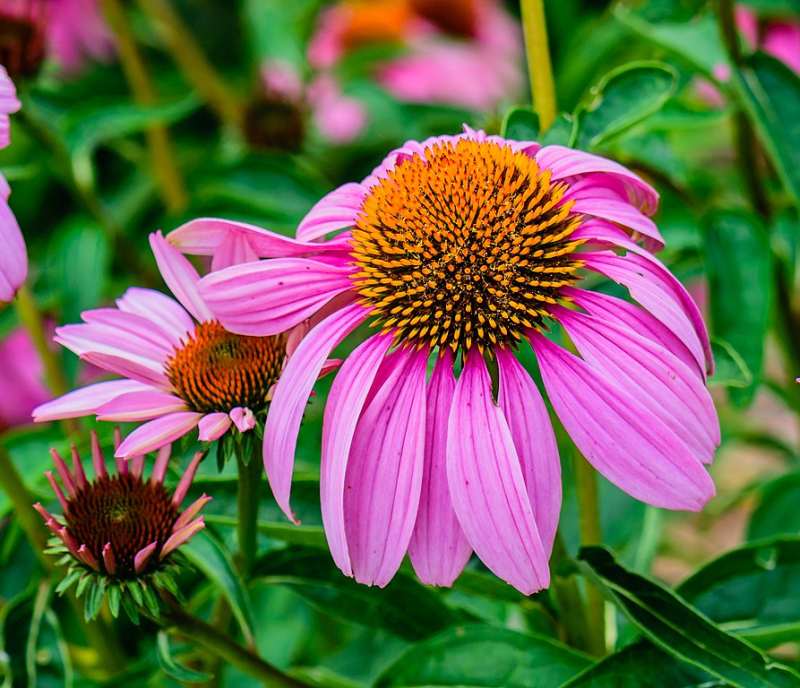
Photo Credit: PumpkinSky / Wikimedia Commons / CC BY-SA 4.0
Purple coneflower is a common yet beautiful flower with its long-blooming, daisy-like purple flowers and a brown-colored center. It’s low maintenance but needs full sun to achieve the best blooms. A landscape with part shade can still have purple coneflower. However, they could eventually flop over.
While you admire this showy wildflower, hummingbirds, bees, butterflies, and finches will also enjoy the purple coneflower.
An overly wet soil does not suit a purple coneflower well–– ensure to only give the plant one inch of water per week during its first growing season and only water during droughts thereafter. Fertilizers shouldn’t be used for purple coneflowers because it can cause the plant to become laggy– instead, opt for compost to provide nutrients.
Plant type: Flower
USDA Hardiness Zone: 3 to 8
Sun: Full sun, partial shade
Soil: Sandy
Duration: Perennial
Fragrance: Light, sweet, honey-like
Bloom time: April to September
Water needs: Medium
Mature height: 2 to 5 feet
Maintenance: Low
How to Choose Native Plants for Your Oklahoma City Landscape
Before you choose native Oklahoma plants for your OKC landscape, evaluate your space — you wouldn’t want a massive native tree if you have a small space. Consider whether you want drought-resistant plants, how much maintenance you wish to perform, and how much shade your property receives.
OKC is in USDA hardiness zone 7, so ensure any other plants (native or non-native) that catch your eye fall into the correct hardiness for OKC.
FAQ About Best Native Plants for Oklahoma City
This article covers several plants that are poisonous when ingested, including blue false indigo, butterfly milkweed, and the raw berries of American black elderberry. If your kids play close by and have curious hands, you may want to avoid growing these native plants.
OKC can see frost through March or April. Most native plants have the best chance of survival if they are planted after the last frost has occurred.
Native plants require less watering, less use of fertilizers, and less use of pesticides. This is great not only for gardeners but for the environment. Pollinators such as bees and butterflies will also be attracted to many native plants.
Where to Find Native Plants in Oklahoma City
The best view is sometimes off the beaten path–– take the scenic route during springtime, and you’re bound to see flower-lined roads with native wildflowers. Bricktown, Turner Falls, and Medicine Park all boast colorful wonders of Oklahoma’s native plants. In addition to seeing native plants along the roadways, you might also spot native plants or purchase native plants at the following locations:
If you want your landscape to include more than just native plants, the best grass types for Oklahoma City can help complete your picturesque backyard oasis. Connect with a local lawn care pro to upkeep your landscape with lawn mowing, edging, and trimming.
Main Image Credit: Bill Wilson / Flickr / CC BY 2.0